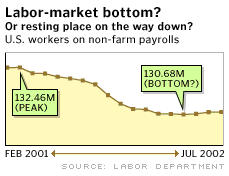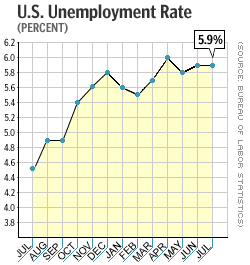NEW YORK (CNN/Money) -
After a brutal 2001, the U.S. labor market, critical to the economy's health, seemed to be on the road to recovery.
But prolonged stock-market weakness and growing talk of a "double-dip" back into a recession that began in March 2001 have some economists worried that more labor-market misery is on the way.
"We could be poised for a second round of layoffs if we see effective demand [for goods and services] fall off -- and I believe we have," said Jeff Winger, a labor economist at the Economic Policy Institute in Washington, D.C.

The economy shed 1.78 million jobs between March 2001 and April 2002, with the worst cuts -- more than 900,000 -- coming during the fourth quarter of 2001.
Though U.S. job growth has been anemic since April 2002, most economists were encouraged by new weekly claims for unemployment benefits trending downward in recent weeks and the number of corporate layoff announcements dwindling.
Chicago outplacement firm Challenger Gray & Christmas Inc., which publishes a closely watched survey of job-cut announcements by U.S. companies, said the number of planned layoffs dropped to 80,966 in July -- 61 percent lower than the number announced in July 2001.
That number implied that July's brutal stock selloff had little impact on corporate hiring and firing practices and raised the hope that the worst of the job cuts were over.
Not so fast.
"The July numbers are still double what we saw in the period of economic expansion," Challenger Gray & Christmas CEO John Challenger said. "They're the lowest in some time, but they're not good by any means."
Challenger and several economists pointed to two ominous signs, found in Friday's less-than-thrilling July employment report from the Labor Department, that hint the labor market is in for another bad spell: a drop in the number of temporary workers on non-farm payrolls and a drop in the number of overtime hours in the manufacturing sector, the first such decline since October 2001.
"Those are two areas of the economy that should be perking up right now if we were in a recovery mode," Challenger said. "Normally, businesses hire temp workers and work their employees longer -- this drop is of real concern and raises the specter of a double-dip recession."
If workers are putting in fewer hours, it could mean they're producing less -- possibly accounting for last week's report from the Institute for Supply Management that showed manufacturing activity slowed to a crawl in July.
Even worse for the economy, fewer hours mean lower paychecks and lower consumer spending, which accounts for about two-thirds of all U.S. gross domestic product (GDP), the broadest measure of the economy.
Challenger's worst-case scenario involved consumers, already worried by growing talk of a double-dip recession and continuing stock-market weakness, getting stung by a drop in the housing market or by a tightening of credit by lenders spooked by rising consumer debt. The result would be a dramatic downturn in consumer spending, leading to another economic downturn and, naturally, more layoffs.
That would hurt consumer spending even more, starting the vicious cycle all over again and making the "jobless" recovery that drove President Bush's father out of office look good in comparison.
A little perspective
So far, at least, most economists don't think this will happen.
David Heuther, chief economist at the National Association of Manufacturers, said in a research note that a weaker dollar has helped exporters and that businesses have begun to increase spending, encouraging manufacturers -- who cut more jobs than any other sector during the downturn -- to start hiring again, possibly in the third quarter.
"Evidence of a double-dip recession has yet to materialize in the data, though it appears that growth may be more moderate than we anticipated earlier in the year," Heuther said.
In technology, the picture is a little more muddled. Software maker Microsoft Corp. (MSFT: Research, Estimates) plans to add about 5,000 jobs in the next 12 months, while chipmaker Intel Corp. (INTC: Research, Estimates) plans to cut 4,000 workers in the second half of 2002. In telecommunications, which has long led the pack in job cuts, the picture is downright dismal.
Economist Kurt Rankin said his firm, Economy.com, expects non-farm payrolls to grow by 140,000 in the third quarter. That's not exactly a cornucopia of jobs, but it's still an improvement over the anemic 67,000 jobs created in the second quarter.

It won't be enough to keep unemployment from rising, however. Many economists say payrolls need to grow by 150,000 jobs per month to keep pace with the growing labor force and keep unemployment down.
Economy.com expects the jobless rate, which is currently at 5.9 percent, to climb to 6.2 percent by the fourth quarter and to hover there in the first quarter.
Of course, that's still pretty low, compared with unemployment's 10.8 percent peak after the 1981-82 recession and its 7.8 percent peak after the 1990-91 recession.
"The level of unemployment we have right now is one we thought of as being normal only a few years ago," noted William Dickens, labor economist at the Brookings Institution. "It shows how far we've come that we're worrying about a lack of recovery with 5.9 percent unemployment."
And the National Bureau of Economic Research, the think tank that names the peaks and bottoms of economic cycles, considers the rise and fall of payrolls more important than the unemployment rate.
The latest recession began when payrolls began to slide from their March 2001 peak, and the NBER said it probably won't declare the recession over until it sees payrolls move back above that peak.
Unfortunately, that's about 1.7 million jobs away, and the number hasn't been in any hurry to move higher, staying about the same since December 2001.
If payrolls begin to fall again significantly, then the dreaded double dip will be a reality.
"The term 'double dip' refers to how we've reached this bottom and then might go into another sharp decline," said Rankin of Economy.com. "It's not moving into and out of recession; it's moving into recession, finding a temporary floor and diving again."

|

